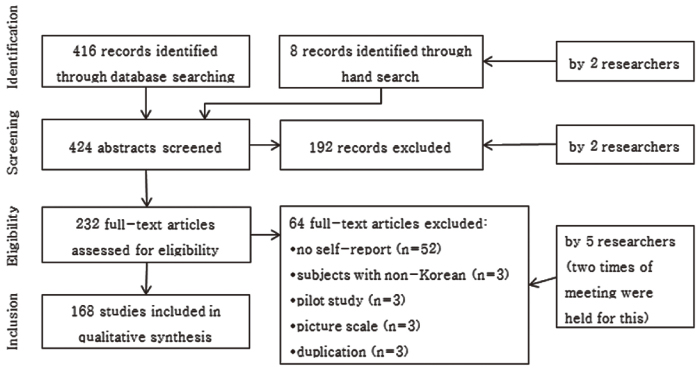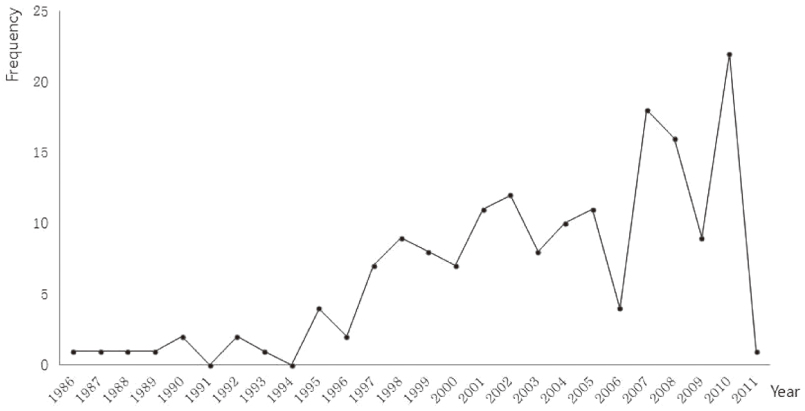J Korean Acad Nurs.
2013 Feb;43(1):50-58. 10.4040/jkan.2013.43.1.50.
Measurement Properties of Self-report Questionnaires Published in Korean Nursing Journals
- Affiliations
-
- 1Graduate School of Public Health, Ajou University, Suwon, Korea.
- 2College of Nursing, Ajou University, Suwon, Korea. ckimha@ajou.ac.kr
- 3College of Nursing, Eulji University, Seongnam, Korea.
- 4College of Nursing, Ajou University, Suwon, Korea.
- 5School of Medicine, Ajou University, Suwon, Korea.
- KMID: 1732665
- DOI: http://doi.org/10.4040/jkan.2013.43.1.50
Abstract
- PURPOSE
The purpose of this study was to evaluate measurement properties of self-report questionnaires for studies published in Korean nursing journals.
METHODS
Of 424 Korean nursing articles initially identified, 168 articles met the inclusion criteria. The methodological quality of the measurements used in the studies and interpretability were assessed using the COnsensus-based Standards for the selection of health Measurement INstruments (COSMIN) checklist. It consists of items on internal consistency, reliability, measurement error, content validity, construct validity including structural validity, hypothesis testing, cross-cultural validity, and criterion validity, and responsiveness. For each item of the COSMIN checklist, measurement properties are rated on a four-point scale: excellent, good, fair, and poor. Each measurement property is scored with worst score counts.
RESULTS
All articles used the classical test theory for measurement properties. Internal consistency (72.6%), construct validity (56.5%), and content validity (38.2%) were most frequently reported properties being rated as 'excellent' by COSMIN checklist, whereas other measurement properties were rarely reported.
CONCLUSION
A systematic review of measurement properties including interpretability of most instruments warrants further research and nursing-focused checklists assessing measurement properties should be developed to facilitate intervention outcomes across Korean studies.
Keyword
MeSH Terms
Figure
Cited by 3 articles
-
Systematic Review of the Pittsburgh Sleep Quality Index used for Measuring Sleep Quality among Adults with Trauma Experiences
Go-Un Kim, Ju Hee Lee
Korean J Adult Nurs. 2019;31(4):337-350. doi: 10.7475/kjan.2019.31.4.337.Psychometrics Properties of Ways of Coping Questionnaire-Korean among College Students
Hwa Soon Kim, Eun Ji Seo, Mi-Ae You, Chun-Ja Kim
Korean J Health Promot. 2021;21(3):101-109. doi: 10.15384/kjhp.2021.21.3.101.Discharge Readiness Scale for Parents of High-Risk Infants: A Systematic Review
Ki-Eun Kim, Hyejung Lee, Na-Young Jeon
J Korean Soc Matern Child Health. 2022;26(4):205-224. doi: 10.21896/jksmch.2022.26.4.205.
Reference
-
1. Bang KS, Lee SO, Park YI, Jun MH, Kim HS, Son HM, et al. Analysis of published papers and their keywords in the Journal of Korean Academic Society of Nursing Education 2007. J Korean Acad Soc Nurs Educ. 2008. 14(2):244–251. http://dx.doi.org/10.5977/JKASNE.2008.14.2.244.2. Bock RD. A brief history of item theory response. Educ Meas: Issue Pract. 1997. 16(4):21–33. http://dx.doi.org/10.1111/j.1745-3992.1997.tb00605.x.3. Brislin RW. Lonner WJ, Berry JW, editors. The wording and translation of research instruments. Field methods in cross-cultural research. 1986. Beverly Hills, CA: Sage;137–164.4. Choi KS, Song MS, Hwang AR, Kim KH, Chung MS, Shin SR, et al. The trends of nursing research in the Journal of the Korean Academy of Nursing. J Korean Acad Nurs. 2000. 30(5):1207–1218.5. Chung BY, Yi MS, Choi EH. Trends of nursing research in the Journal of Oncology Nursing. J Korean Oncol Nurs. 2008. 8(1):61–66.6. DeVon HA, Block ME, Moyle-Wright P, Ernst DM, Hayden SJ, Lazzara DJ, et al. A psychometric toolbox for testing validity and reliability. J Nurs Scholarsh. 2007. 39(2):155–164. http://dx.doi.org/10.1111/j.1547-5069.2007.00161.x.7. Jeong GH, Ahn YM, Cho DS. Coincidence analysis of keywords of the Journal of Korean Academy of Nursing with MeSH. J Korean Acad Nurs. 2005. 35(7):1420–1425.8. Kane RL. Understanding health care outcomes research. 2006. 2nd ed. Sudbury, Massachusetts: Jones and Bartlett.9. Kang HC. Analysis of statistical method applied in the Journal of Korean Academy of Nursing for recent 3 years (1999-2001). J Korean Acad Nurs. 2002. 32(6):929–935.10. Kim JI, Lee EH, Kang HS, Oh HE, Lee EJ, Jun EM, et al. Analysis of published papers by keywords and research methods in the Korean Journal of Women Health Nursing (2007-2009). Korean J Women Health Nurs. 2010. 16(3):307–316. http://dx.doi.org/10.4069/kjwhn.2010.16.3.307.11. Lawshe CH. A quantitative approach to content validity. Pers Psychol. 1975. 28(4):563–575. http://dx.doi.org/10.1111/j.1744-6570.1975.tb01393.x.12. Lee EH, Kim JS. Major effect models of social support and its statistical methods in Korean nursing research. J Korean Acad Nurs. 2000. 30(6):1503–1520.13. Lim NY, Kim JI, Lee EN, Lee KS, Lee I, Cho KS, et al. The analysis on published research in the Journal of Muscle and Joint Health. J Muscle Joint Health. 2010. 17(1):79–88. http://dx.doi.org/10.5953/JMJH.2010.17.1.079.14. Lynn MR. Determination and quantification of content validity. Nurs Res. 1986. 35(6):382–385. http://dx.doi.org/10.1097/00006199-198611000-00017.15. Mokkink LB, Terwee CB, Patrick DL, Alonso J, Stratford PW, Knol DL, et al. The COSMIN study reached international consensus on taxonomy, terminology, and definitions of measurement properties for health-related patient-reported outcomes. J Clin Epidemiol. 2010. 63(7):737–745. http://dx.doi.org/10.1016/j.jclinepi.2010.02.006.16. Munro BH. Statistical methods for health care research. 2005. 5th ed. Philadelphia, PA: Lippincott Williams & Wilkins.17. Polit DF, Beck CT. Essentials of nursing research: Appraising evidence for nursing practice. 2010. 7th ed. Philadelphia, PA: Lippincott Williams & Wilkins.18. Seong TJ. Understanding and application of item response theory. 2001. Paju: Kyoyookbook.19. Shin HS, Hyun MS, Ku MO, Cho MO, Kim SY, Jeong JS, et al. Analysis of research papers published in the Journal of the Korean Academy of Nursing-focused on research trends, intervention studies, and level of evidence in the research. J Korean Acad Nurs. 2010. 40(1):139–149. http://dx.doi.org/10.4040/jkan.2010.40.1.139.20. Terwee CB, Mokkink LB, Knol DL, Ostelo RW, Bouter LM, de Vet HC. Rating the methodological quality in systematic reviews of studies on measurement properties: A scoring system for the COSMIN checklist. Qual Life Res. 2012. 21(4):651–657. http://dx.doi.org/10.1007/s11136-011-9960-1.21. Watkins K, Connell CM. Measurement of health-related QOL in diabetes mellitus. Pharmacoeconomics. 2004. 22(17):1109–1126.
- Full Text Links
- Actions
-
Cited
- CITED
-
- Close
- Share
- Similar articles
-
- A Systematic Review of Measurement Properties of Spirituality related Assessment Tools Published in Korean Journals
- Current status of systematic review studies on patient-reported outcome measures published in Korean journals
- Psychometric properties of an instrument 2: structural validity, internal consistency, and cross-cultural validity/measurement invariance
- Measurement Properties of Self-Report Questionnaires Measuring the Social Adjustment for Youth after Treatment of Childhood Cancer: Systematic Review
- Evaluation of Studies on the Measurement Properties of Self-Reported Instruments



